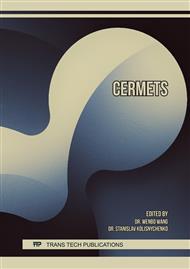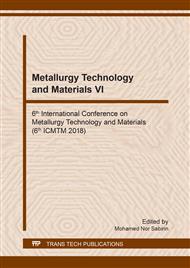p.99
p.104
p.109
p.113
p.119
p.124
p.130
p.135
p.143
Preparation and Characterization of Al2O3-Al Cermet with Coated Microstructure Using Powder Metallurgy Method
Abstract:
Cermet includes the excellent properties of ceramic materials and the advantages of metal materials, so it is an important new engineering material. In this paper, Al2O3-Al cermet is prepared using different molding process via the powder metallurgy method to study the properties of Al2O3-Al cermet. The conclusion are shown the increasing density of Al2O3-Al cermet is not obvious with increasing the forming pressure of cermet body during the initial and late processing, but the increasing density is more obvious under the forming pressure for 20-30MPa. The density of cermet materials are increased with prolonging holding pressure time, the initial increase speed is faster, and the later growth rate becomes weaker. When the molding pressure is 30MPa, the holding time is 10min, the sintering temperature is 900°C, the holding time is 1h, the prepared Al2O3-Al cermet adding sintering aids has a coated microstructure, which indicates that the large number of particles is migrated on the grain boundary. The sample density is 2.26g/cm3, the density is highest, the distribution of Al2O3 and Al phase is the most uniform. The buried sintering method is more suitable for the preparation of Al2O3-Al cermet composites than the nudity sintering method.
Info:
Periodical:
Pages:
119-123
Citation:
Online since:
August 2018
Authors:
Keywords:
Price:
Сopyright:
© 2018 Trans Tech Publications Ltd. All Rights Reserved
Share:
Citation:



